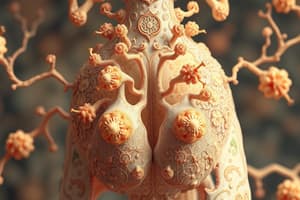Podcast
Questions and Answers
What are the primary cell types present in the pars distalis of the adenohypophysis?
What are the primary cell types present in the pars distalis of the adenohypophysis?
- Follicular cells and C cells
- Chromophobes and chromophils (correct)
- Neuron cells and glial cells
- Erythrocytes and leukocytes
What distinguishes acidophils from basophils in the pars distalis?
What distinguishes acidophils from basophils in the pars distalis?
- Acidophils are found in clusters
- Acidophils secrete growth hormone (correct)
- Acidophils have a high granule content
- Acidophils stain poorly
Which type of chromophil is primarily responsible for the secretion of growth hormone?
Which type of chromophil is primarily responsible for the secretion of growth hormone?
- Chromophobes
- Basophils
- Somatotrophs (correct)
- Mammotrophs
Which staining technique can be used for accurate identification of different chromophils?
Which staining technique can be used for accurate identification of different chromophils?
In what percentage do mammotrophs constitute the cell population in multiparous females?
In what percentage do mammotrophs constitute the cell population in multiparous females?
What is the main role of chromophobes in the adenohypophysis?
What is the main role of chromophobes in the adenohypophysis?
Which cell type makes up approximately 50% of the epithelial cells in the pars distalis?
Which cell type makes up approximately 50% of the epithelial cells in the pars distalis?
What is the main structural difference between the two types of acidophils, somatotrophs and mammotrophs?
What is the main structural difference between the two types of acidophils, somatotrophs and mammotrophs?
What is a characteristic feature of somatotrophs observed under an electron microscope?
What is a characteristic feature of somatotrophs observed under an electron microscope?
Which part of the adenohypophysis is the largest?
Which part of the adenohypophysis is the largest?
Flashcards are hidden until you start studying
Study Notes
Adenohypophysis Overview
- Glandular epithelial part of the pituitary gland, stained deeply with H&E.
- Divided into three parts: Pars distalis, Pars tuberalis, Pars intermedia.
Pars Distalis
- Largest portion of the adenohypophysis.
- Contains stroma and parenchyma components.
- Stroma has a thin connective tissue capsule with delicate reticular fibers supporting blood sinusoids.
- Parenchyma consists of irregular cords or clusters of secretory endocrine cells along with blood sinusoids.
Cell Types in Pars Distalis
- Classified based on staining affinity into Chromophobes and Chromophils.
- Chromophobes:
- Constitute 50% of epithelial cells, poor affinity for staining due to fewer granules.
- Serve as reserve cells, capable of differentiating into Chromophils.
- Chromophils:
- Comprise the other 50% of epithelial cells, high staining affinity due to abundant hormone granules.
Chromophil Subtypes
- Further divided into Acidophils and Basophils based on staining characteristics.
Acidophils
- Two types present: Somatotrophs and Mammotrophs.
Somatotrophs
- Most numerous acidophil subtype, responsible for secretion of somatotropin (growth hormone).
- Identified by large euchromatic nucleus with prominent nucleoli and well-developed Golgi apparatus.
Mammotrophs (Lactotrophs)
- Constitute approximately 9% of the cell population in males and nulliparous females, and up to 31% in multiparous females.
- Secrete prolactin and distributed individually, not in clusters.
- Cytological features similar to somatotrophs but have fewer elongated cisternae of rough endoplasmic reticulum (RER) when compared.
Acidophil Characteristics
- Both types are large rounded cells with central rounded nuclei and acidophilic cytoplasm.
- Exhibits negative PAS reaction and positive orange G stain, helping in identification.
- Somatotrophs have numerous electron-dense granules (300-350 nm) while mammotrophs exhibit larger granules (500-900 nm) during pregnancy.
Ultrastructural Features
- Somatotrophs possess small rod-shaped mitochondria and a well-developed Golgi apparatus with parallel RER.
- Mammotrophs have a highly developed RER during pregnancy, with Golgi apparatus reaching near nuclear size and abundant lysosomes present.
Studying That Suits You
Use AI to generate personalized quizzes and flashcards to suit your learning preferences.


